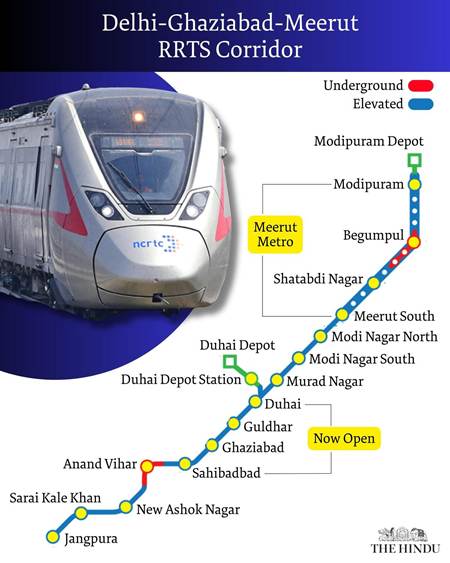
8. (c) What are the major regional rapid transit systems developed in India? How are urban problems being addressed by them? 15 Marks (PYQ/2024)
Answer:
Introduction
India’s urban centers have witnessed exponential growth over recent decades, leading to persistent problems such as traffic congestion, air pollution, and inefficient public transport. In response, the country has developed various regional rapid transit systems—including Metro Rail, Bus Rapid Transit Systems (BRTS), and emerging Regional Rapid Transit Systems (RRTS)—to promote ease of mobility, reduce environmental stress, and bolster economic productivity. These transit systems are fundamental to urban renewal and sustainable development.
Models
Urban Mobility and Network Models
- Urban Mobility Model (Network Governance): This model explains how rapid transit systems act as growth poles or nodes in urban networks. By connecting key economic and residential hubs, systems like the Delhi Metro and Ahmedabad Janmarg BRTS stimulate regional development and drastically reduce travel time. Key Insight: Effective transit networks create multiple overlapping benefits—reducing congestion, lowering carbon emissions, and boosting economic activity. Source: DMRC Annual Reports; Economic Survey of India (2023).


- Spatial Diffusion Models using GIS: Geographic Information Systems (GIS) are employed to analyze the distribution of transit corridors and their influence on urban sprawl. This model helps planners identify corridors where transit solutions can radically transform urban land use. Key Insight: Quantitative spatial analysis supports evidence-based planning that aligns rapid transit development with urban densification and land-use changes.
Theories
Transit-Oriented Development and Diffusion Theories
- Transit-Oriented Development (TOD) Theory: TOD emphasizes clustering high-density, mixed-use development in the vicinity of transit hubs. It is championed by urban planning scholars such as Peter Calthorpe. Key Insight: TOD not only enhances accessibility but also promotes sustainable land use and reduces reliance on private vehicles.
- Diffusion of Innovation (Everett Rogers): This theory explains how novel transit solutions spread through urban regions by demonstrating clear relative advantages—for example, reduced commute times and increased reliability—thus accelerating their adoption across cities.
Key Insight: As innovative transit systems prove their worth, their design features and operational protocols become models for replication in other cities.
Laws
Legal and Policy Frameworks
- National Urban Transport Policy (NUTP): Launched to transform urban mobility, the NUTP provides guidelines for the implementation of mass rapid transit systems and supports Public–Private Partnership (PPP) models. It mandates improvements in urban infrastructure and sustainable mobility.
- Regulatory Frameworks for Metro Rail Projects: Legal provisions such as clearances under the Railways Act and environmental norms set by the Environment (Protection) Act, 1986 ensure that transit systems are both socially beneficial and environmentally sound. Source: Ministry of Urban Development; Official Gazette, Government of India.
Perspectives
Political Economy and Sustainable Development Perspectives
- Political Economy Perspective (Immanuel Wallerstein): This perspective examines how transit investments reshape power dynamics, fostering equitable growth and reducing spatial disparities between urban cores and peripheries. Key Insight: By promoting infrastructural equity, rapid transit can empower previously marginalized urban areas.

- Sustainable Development Perspective (Brundtland Commission): Emphasizes that economic growth must be balanced with environmental and social well-being. Integrating rapid transit reduces emissions and promotes healthier urban living costs. Key Insight: Sustainable urban transport systems are integral to achieving long-term environmental and economic resilience.

Case Studies
Case Study 1: Delhi Metro
- Overview: The Delhi Metro is a flagship rapid transit system, covering over 350 km of routes, serving more than 2.76 million daily passengers.
- Impact: It has significantly reduced road congestion, cut down travel time by up to 50%, and has decreased vehicular emissions in the capital.
- Source: DMRC Annual Report (2023); Economic Survey of India.
Case Study 2: Ahmedabad Janmarg BRTS
- Overview: The Janmarg BRTS in Ahmedabad pioneers dedicated bus lanes, offering an affordable, high-capacity transportation alternative.
- Impact: Daily ridership exceeds 200,000 passengers, with the system contributing to a 25% reduction in travel time on key corridors and promoting non-motorized last-mile connectivity.
- Source: PIB Reports (2022); Ahmedabad Municipal Corporation data.
Conclusion
Major regional rapid transit systems in India—exemplified by the Delhi Metro and Ahmedabad Janmarg BRTS—address critical urban problems such as congestion, pollution, and inefficient mobility. By applying urban mobility models, leveraging theories like TOD and Diffusion of Innovation, and implementing robust legal frameworks, these systems are transforming the urban landscape. With integrated political economy and sustainable development perspectives, rapid transit stands as a cornerstone for building resilient, livable, and equitable cities in India.
Tag:ahmedabad janmarg network, delhi metro, Diffusion of Innovation, Geography Case Study, Geography Optional, geography optional case study, Geography Optional Pyq, geography optional pyq 2024, human geography, Indian Geography, models theories laws and perspective in geography, Political Economy Perspective (Immanuel Wallerstein), regional rapid transit systems in india, Sustainable Development Perspective (Brundtland Commission), urban mobility model


